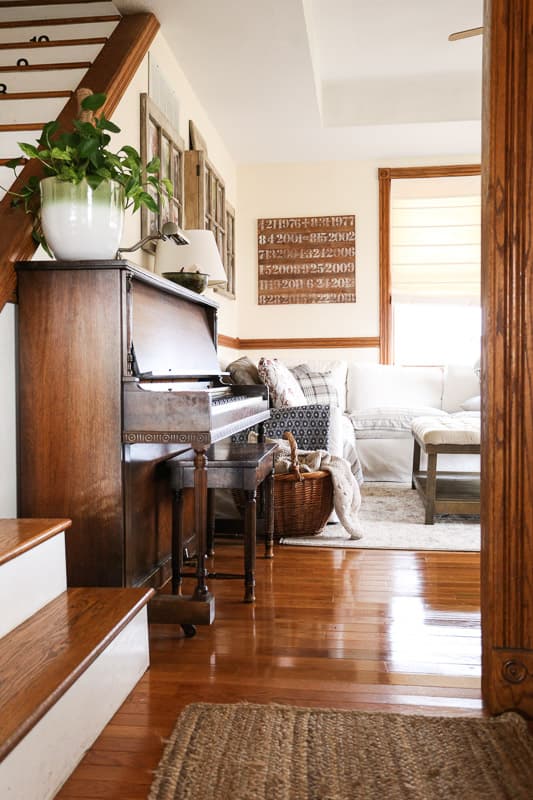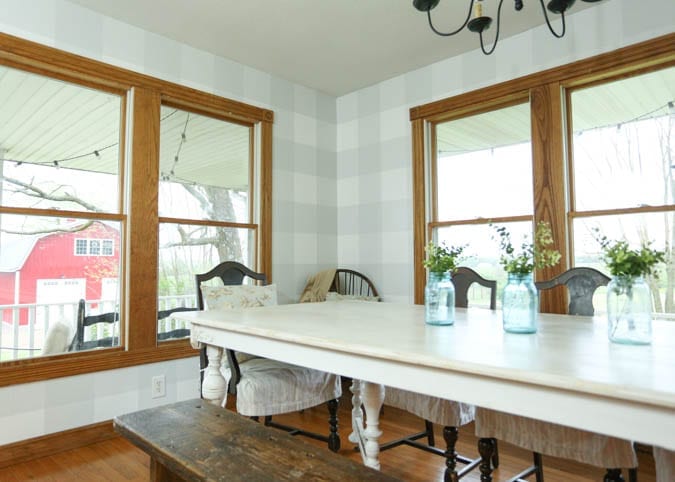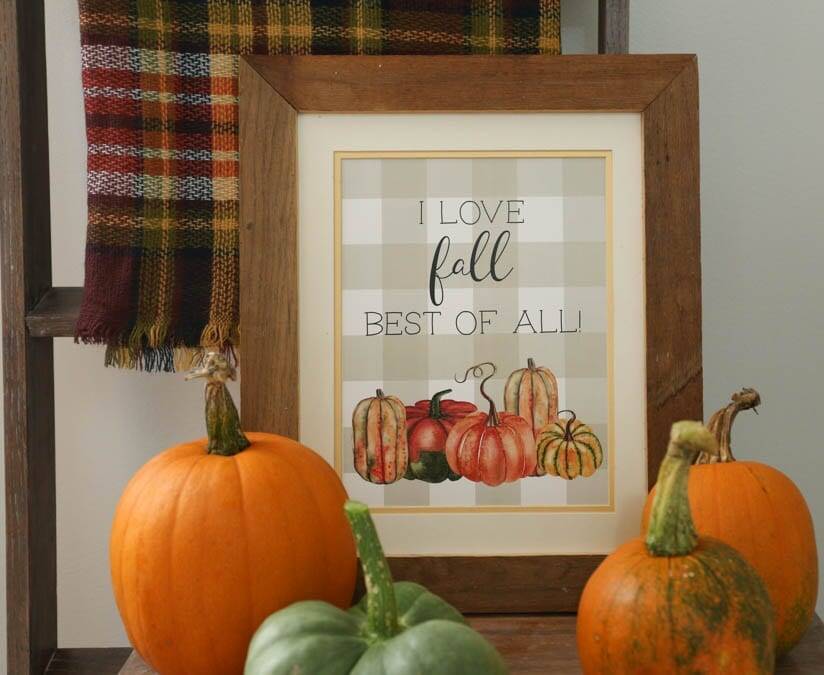Minimalist Cottagecore Home Style: The Perfect Blend
Minimalist Cottagecore represents a harmonious fusion of two worlds. It celebrates the core principles of Cottagecore—natural elements, vintage charm, and rustic simplicity—while adhering to the clean, clutter-free aesthetic of minimalism. The result is a style that is cozy and uncluttered, warm and simple, inviting and tranquil.
Do you ever have a hard time describing your home style? I do, and I’m thinking this one might be it! I love to create a warm and inviting space but I’m not one to create vignettes or to have collections. Simplicity is more my style. However, I wouldn’t have identified as a minimalist because that style always looked so stark and rather modern to me.
Cottagecore examples seemed to have too much stuff but I loved the natural elements and the inviting feeling that the style evoked. So why not combine the two?

The Essence of Minimalist Cottagecore
Minimalist Cottagecore represents a harmonious fusion of two worlds. It celebrates the core principles of Cottagecore—natural elements, vintage charm, and rustic simplicity—while adhering to the clean, clutter-free aesthetic of minimalism. The result is a style that is cozy and uncluttered, warm and simple, inviting and tranquil.
Key Elements of Minimalist Cottagecore
In the world of interior design, two seemingly opposing styles, Minimalism and Cottagecore, have captured the hearts of homeowners looking for a sense of simplicity and connection with nature. Minimalism encourages a life free from clutter and excess, while Cottagecore invites the warmth and charm of rural living into our homes. In this post, we’ll explore how to seamlessly blend these two styles to create a Minimalist Cottagecore home that exudes serenity and simplicity.
- Natural Materials: The use of natural materials such as wood, stone, and organic textiles forms the foundation of Minimalist Cottagecore. These materials add warmth and a connection to nature while maintaining a minimalist aesthetic.
- Simplicity and Clutter Reduction: Minimalism encourages the elimination of unnecessary clutter. This is seamlessly integrated into Minimalist Cottagecore by paring down the decor to only the essentials, allowing each piece to shine and the space to breathe.
- Vintage and Antique Finds: Vintage and antique pieces play a significant role in Minimalist Cottagecore. They bring character, history, and a touch of the past into your modern home, without overwhelming the space.
- Neutral Color Palette: A neutral color palette, with soft and muted tones, creates a serene atmosphere in a Minimalist Cottagecore home. Whites, beiges, and pale pastels dominate the color scheme, allowing the natural elements to take center stage.
- Cozy and Functional Furniture: Minimalist Cottagecore furniture is both cozy and functional. Think comfortable seating, practical storage solutions, and pieces that echo the rustic charm of the countryside.
- Handmade and Personal Touches: Just as in traditional Cottagecore, handcrafted and personal elements find a place in Minimalist Cottagecore. Handmade blankets, DIY ceramics, or hand-painted artwork add a unique touch to your decor.
- A Touch of Nature: Incorporating elements from the natural world, such as houseplants or fresh flowers, is essential in Minimalist Cottagecore. These elements infuse your space with vitality and tranquility.
- Artwork: Choose art that reflects the beauty of rural life, the photo above is my favorite. It gives me all the feelings of the life I love!
Creating Your Minimalist Cottagecore Home
Now that we’ve established the essence of Minimalist Cottagecore, let’s explore how to create your own blend of these two styles in your home.

1. Start with a Neutral Canvas
Begin by creating a neutral canvas in your home. Consider painting your walls with soft and muted colors like light gray, beige, or soft pastels. These hues will serve as the backdrop for your Minimalist Cottagecore decor, creating a calming and inviting atmosphere.
I used to paint all of my walls bold colors and I would use artistic paint techniques. However, in the last ten years, I have almost always chosen off-white for my walls. This allows me to change up furniture or pillows without concern for how it will go with the paint colors.
2. Embrace Natural Materials
Integrate natural materials into your decor. Wooden furniture, stone countertops, and organic textiles like linen and cotton are essential in creating a connection to the earth. These elements add warmth and texture to your space without overwhelming it with visual noise.
Don’t be afraid to mix wood tones. Our home has golden oak everywhere…it’s not my favorite. However, I have learned to bring in darker and lighter woods and honestly, I like the way it all looks together.
3. Curate Your Decor
In Minimalist Cottagecore, less is often more. Carefully select decor items that resonate with both styles. Vintage and antique pieces should be thoughtfully chosen to bring character and history into your home. Look for classic wooden furniture, such as a weathered farmhouse table or a vintage armoire, to add that rustic charm.
A collected look is so inviting. I never feel at home in a place where everything is new and coordinates perfectly. I like the look of a home that has been built over time.
4. Pare Down the Clutter
Minimalism places a strong emphasis on decluttering and reducing excess. In your Minimalist Cottagecore home, it’s essential to follow this principle. Keep your space uncluttered by limiting the number of decor items and furnishings in each room. Only showcase what truly speaks to you and enhances the cozy and rustic aesthetic.
See my tips on decluttering your home here.
5. Cozy and Functional Furniture
Invest in cozy yet functional furniture that meets the needs of your daily life. Opt for comfortable seating, whether it’s a plush sofa with soft cushions or a set of welcoming armchairs. Storage solutions like rustic bookshelves, wooden chests, or vintage cabinets should seamlessly blend with your decor.
I have an addiction to white furniture, it’s rather obnoxious really. We have ten children, and keeping it clean is impossible. Even when I was a new mom with minimal sewing skills I would sew white slipcovers for my furniture. While it is nice to be able to wash them, that does become a chore over time.
I have started draping linens over my white furniture and I really love the layered look! It allows me to have my beloved white but helps me to go longer between washing!
6. Handmade and Personal Touches
Add handmade and personal elements to your Minimalist Cottagecore home. Craft your own throw blankets, create hand-painted artwork, or make DIY ceramics. These items will add a personal touch and unique character to your space, elevating it beyond the ordinary.

7. Bring the Outdoors In
Incorporate elements from the natural world to infuse your home with vitality and tranquility. Houseplants and fresh flowers are perfect additions. Choose plants that are easy to maintain, such as succulents or snake plants, to keep the upkeep simple and in line with the minimalist approach.
8. Balance Simplicity and Charm
Striking a balance between simplicity and charm is the key to achieving the perfect Minimalist Cottagecore aesthetic. While minimalism encourages simplicity and functionality, Cottagecore celebrates charm and comfort. Use these styles in harmony to create a space that feels both inviting and peaceful.
A Minimalist Cottagecore Color Palette
The color palette is a crucial aspect of Minimalist Cottagecore, as it sets the tone for the entire space. Here are the key colors that define this harmonious blend:
1. Neutral Shades
Neutral shades form the foundation of the color palette in Minimalist Cottagecore. These colors create a serene and timeless backdrop for your decor:
- White: A clean and pure hue that brightens your space and allows other elements to shine.
- Beige: A warm, inviting shade that complements the natural materials and rustic elements in your decor.
- Soft Gray: A versatile and calming color that pairs well with other muted tones.
- Cream: A neutral and elegant shade that adds a touch of luxury to your home.

2. Soft Pastels
Soft pastel hues from the Cottagecore palette can be used as accents in your Minimalist Cottagecore home:
- Sage Green: A timeless pleasant color that feels peaceful
- Powder Blue: A soft and dreamy blue that adds a touch of whimsy to your space.
- Pale Pink: A delicate and romantic color perfect for textiles and accents.
- Muted Yellow: A warm and inviting shade that brings a touch of sunshine indoors.
These colors can be incorporated through throw pillows, artwork, or decorative items to add a touch of Cottagecore charm to your minimalist space.
3. Earthy Tones

Earthy tones provide a connection to nature and balance the soft pastels and neutrals:
- Rustic Brown: A rich, earthy brown that works well for wooden furniture and accents.
- Terracotta: A warm, reddish-brown color that adds a touch of the countryside to your decor.
- Olive Green: A muted green that brings a natural and serene vibe to your space.
These earthy tones can be used for larger furniture pieces or as accent colors to enhance the Cottagecore feel in your home.
4. Vintage and Antique Touches

Vintage and antique pieces can add a splash of color and character to your Minimalist Cottagecore decor. Look for pieces with worn, chipped paint or aged patina that naturally add depth and charm to your home.
Vintage and antique pieces can add a splash of color and character to your Minimalist Cottagecore decor. Look for pieces with worn, chipped paint or aged patina that naturally add depth and charm to your home.

In the pursuit of a serene and inviting home, Minimalist Cottagecore emerges as a delightful compromise between minimalism and the cozy charm of Cottagecore. By seamlessly blending natural materials, vintage finds, and a thoughtful color palette, you can create a living space that feels both tranquil and timeless. Embrace the simplicity, appreciate the charm, and savor the beauty of your Minimalist Cottagecore haven.







